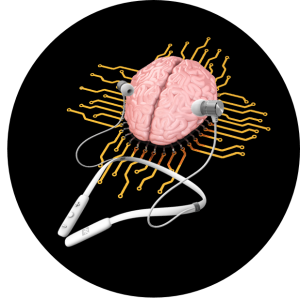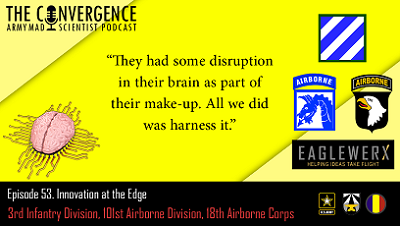[Editor’s Note: Army Mad Scientist is pleased to present our latest episode of The Convergence podcast, featuring senior military leaders, field and company grade officers, and young Soldiers discussing innovation at the unit and individual level, thinking differently about modern warfare, and implementing grassroots transformation in the 3rd Infantry Division, 101st Airborne Division, and 18th Airborne Corps — Enjoy!]
[If the podcast dashboard is not rendering correctly for you, please click here to listen to the podcast.]
In today’s interview, Senior Leaders and Soldiers discuss how the Army is successfully harnessing its disruptive thinkers to cultivate innovation at the tactical level. The following bullet points highlight key insights from our interview:
-
-
- The 3rd Infantry Division’s The Marne Think Tank, the 101st Airborne Division’s EAGLEWERX, and the 18th Airborne Corps’ Dragon’s Lair are leading the U.S. Army’s efforts to crowd-source innovative ideas from every echelon of the force. While innovation tends to focus on technology, these organizations also invite creative ideas on policy, process, and quality of life.
-
-
-
- These organizations provide opportunities for Soldiers to pitch their ideas to senior leaders, then collaborate with their peers to refine their ideas and create actionable solutions. Soldiers themselves lead their projects, developing leadership, creativity, and problem-solving skills.
-
-
-
- Innovation requires both time and resources — the Army must dedicate specific time to innovation, particularly outside of focused technology development efforts. This tactical-level innovation, harnessing insights from Soldiers on better ways to perform missions and duties, is often overlooked. Ideas can range from the adoption of preparedness measures for assault survivors to new methods of range scheduling, team cohesion building, and rucksack transportation.
-
-
-
- Prerequisites for innovation include a welcoming environment and platform rather than extensive incentive structure. Soldiers already want to improve the Army – providing a positive space for them to proactively engage and collaborate on problems allows disruptive seekers to find each other and excel at innovation.
-
-
-
- The Army can cultivate its tactical innovators by fostering partnerships with academia and industry. By building a network ecosystem of interested parties, Soldiers are empowered to leverage existing technologies and processes in new ways to help solve Army problems now.
-
 Stay tuned to the Mad Scientist Laboratory for our next episode of The Convergence podcast — Crossing the Valley of Death for Innovation — featuring Trish Martinelli and David Schiff, both At-Large Regional Directors with the National Security Innovation Network, discussing innovation, the value of hackathons and crowd-sourcing in harnessing the Nation’s intellect to benefit National Security, and integrating their programs in support of U.S. Army innovation.
Stay tuned to the Mad Scientist Laboratory for our next episode of The Convergence podcast — Crossing the Valley of Death for Innovation — featuring Trish Martinelli and David Schiff, both At-Large Regional Directors with the National Security Innovation Network, discussing innovation, the value of hackathons and crowd-sourcing in harnessing the Nation’s intellect to benefit National Security, and integrating their programs in support of U.S. Army innovation.
If you enjoyed this post and podcast, check out the following related content addressing Innovation:
Keeping the Razor’s Edge: 4th PSYOP Group’s Innovation and Evolution Council, by the 4th Psychological Operations Group (4th POG) Innovation and Evolution Council
Strategic Latency Unleashed!, Going on the Offensive in the Fight for the Future, and associated podcast with former Undersecretary of the Navy (and proclaimed Mad Scientist) James F. “Hondo” Geurts and Dr. Zachary S. Davis
Tactical Innovation: The Missing Piece to Enable Army Futures Command, by LTC Jim Armstrong
The Convergence: The Future of Ground Warfare with COL Scott Shaw and associated podcast
The Convergence: Innovating Innovation with Molly Cain and associated podcast
Dense Urban Hackathon – Virtual Innovation
“Once More unto The Breach Dear Friends”: From English Longbows to Azerbaijani Drones, Army Modernization STILL Means More than Materiel and Making the Future More Personal: The Oft-Forgotten Human Driver in Future’s Analysis, by Ian Sullivan
Mission Engineering and Prototype Warfare: Operationalizing Technology Faster to Stay Ahead of the Threat by The Strategic Cohort at the U.S. Army Tank Automotive Research, Development, and Engineering Center (TARDEC).
Four Elements for Future Innovation by Dr. Richard Nabors
The Changing Dynamics of Innovation
Innovation Isn’t Enough: How Creativity Enables Disruptive Strategic Thinking, by Heather Venable
Disclaimer: The views expressed in this blog post do not necessarily reflect those of the U.S. Department of Defense, Department of the Army, Army Futures Command (AFC), or Training and Doctrine Command (TRADOC).

